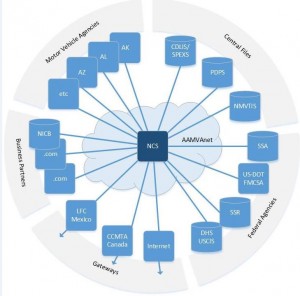

| Online: | |
| Visits: | |
| Stories: |

| Story Views | |
| Now: | |
| Last Hour: | |
| Last 24 Hours: | |
| Total: | |
How the REAL-ID Act is creating a national ID database
Be prepared for the next great transfer of wealth. Buy physical silver and storable food.
papersplease.org / Feb 11, 2016
 [The REAL-ID “hub” connects state and Federal agencies, private commercial third parties, and centralized, national database files. AAMVA SPEXS Master Specification (AMIE), r6.0.8, page 5]
[The REAL-ID “hub” connects state and Federal agencies, private commercial third parties, and centralized, national database files. AAMVA SPEXS Master Specification (AMIE), r6.0.8, page 5]
One of the big lies being told by supporters of the REAL-ID Act of 2005 is that, as the DHS says on its official “Rumor Control” page, “Fact: REAL ID does not build a national database nor does it grant the Federal Government or another state access to a state’s driver’s license data.”
In fact, as we’ve been pointing out, the REAL-ID Act is both building a national database and requiring any state that wants to issue drivers’ licenses or state ID cards that are “compliant” with the REAL-ID Act togrant all other states access to their state’s drivers’ license and ID card data.
Many state legislators and residents of states that are considering whether to start issuing “compliant” driver’s licenses are concerned about (a) whether this would affect residents of those states who “opt out” or choose not to have a gold-starred compliant license (it would, as we’vediscussed previously), (b) whether there would be a central database or list of all drivers or ID cardholders (there would be, as discussed below), and (c) what we mean when we say that the goal of the REAL-ID Act is the creation of a “distributed” national ID database in which a single query routed through the central “hub” can retrieve data from every state ID database.
The post How the REAL-ID Act is creating a national ID database appeared first on Silver For The People.
Thanks to BrotherJohnF
Source: http://silveristhenew.com/2016/02/15/how-the-real-id-act-is-creating-a-national-id-database/


